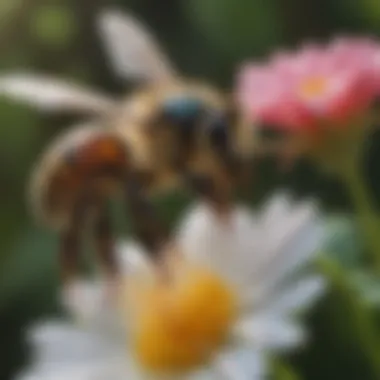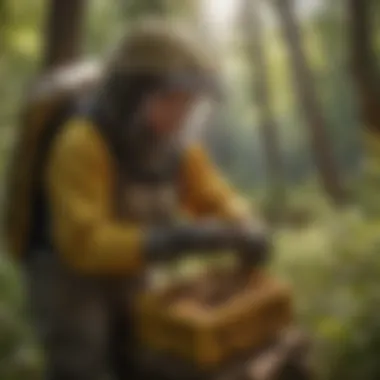The Role of Bees in Pollination and Biodiversity


Intro
Bees play a crucial role in the intricate web of life, particularly in the realm of plant-pollinator relationships. This article examines how bees contribute to biodiversity through their role in pollination. Understanding this connection is essential for forestry professionals and academics who seek to deepen their knowledge of ecological systems.
Pollination is a process that facilitates the reproduction of flowering plants. It occurs when pollen from the male parts of a flower is transferred to the female parts. Bees, as primary pollinators, enhance the reproductive success of many plant species. This not only supports plant populations but also influences the entire ecosystem.
The relationship between bees and plants is mutualistic. Plants provide nectar and pollen as food sources for bees, while bees assist in the fertilization of plants. This interdependency fosters the survival of both groups and maintains biodiversity in ecosystems. As such, the decline in bee populations poses a significant threat not just to agricultural yields but also to the stability of natural habitats.
In this article, we will explore various dimensions of this relationship, including forestry practices, sustainable management strategies, and woodland stewardship. Each section will lead to a better understanding of how to enhance and protect these vital connections.
Understanding Bee Pollination
The significance of bee pollination extends far beyond the act of transferring pollen from one flower to another. It is a vital process that facilitates sexual reproduction in many plant species, ensuring the production of seeds and fruits. This intricate relationship between bees and plants forms the backbone of numerous ecosystems. Understanding how this relationship functions can illuminate the broader implications for biodiversity and ecological stability.
Biological Mechanisms of Pollination
Bee pollination occurs through various biological mechanisms that demonstrate the sophistication of this natural process. When bees visit flowers in search of nectar, they inadvertently collect pollen on their bodies. The hairs on their bodies play a crucial role here, as they allow pollen to adhere and be carried from one bloom to another. This process is not just accidental; it is essential for the fertilization of plants.
Different plants have evolved diverse floral structures and scent profiles to attract specific bee species, enhancing the efficiency of pollination. For example, the shape, color, and odor of flowers can determine which bees are drawn to them. Moreover, many plants have evolved specialized strategies, such as offering larger amounts of nectar or the development of landing platforms to facilitate the visitation process.
In some cases, plants have developed mutualistic relationships with bees at a genetic level, showcasing a remarkable co-evolution. These interactions maximize reproductive success, ensuring that both the plant and the bee benefit from the relationship.
Role of Bees in Ecosystems
Bees play a multifaceted role in ecosystems that goes beyond mere pollination. They are crucial contributors to the maintenance of biodiversity. By facilitating the reproduction of a wide variety of plants, bees help sustain food webs that support countless species.
Their impact is observed not just in wildflower populations, but also in agricultural systems. Crops such as almonds, blueberries, and cucumbers, which rely heavily on bee pollination, demonstrate the economic importance of these insect populations. Without bee pollination, the yields of these crops could significantly decline.
Moreover, the role of bees can influence the composition of vegetation, which in turn affects habitat structure for various wildlife. The relationship between bees and plants is an essential factor in stabilizing ecosystems, as healthy bee populations lead to robust plant communities.
"The decline of bee populations could have catastrophic effects on ecosystems and agriculture, highlighting the need for a deeper understanding of bee pollination and its implications for biodiversity."
Types of Plants Pollinated by Bees
Bees play an essential role in pollination across various plant groups, significantly influencing biodiversity. Understanding the types of plants that rely on bees helps highlight the interconnectedness of ecosystems. This section sheds light on the various plant categories crucial to both environmental health and agricultural productivity.
Wildflowers and Native Plants
Wildflowers and native plants are vital for healthy ecosystems. They provide habitat and food for bees and other pollinators. Many native plants have co-evolved with specific bee species, leading to intricate relationships. These plants often have unique adaptations that attract bees, such as specific colors, shapes, and scents.
Key aspects include:
- Diversity: The presence of wildflowers increases plant diversity, enhancing nutrient cycling in ecosystems.
- Habitat creation: They offer shelter for various wildlife, thus maintaining a balanced ecosystem.
- Seasonal blooms: Wildflowers typically bloom at different times, ensuring a continuous food source for pollinators throughout the growing season.
Native plants, in particular, are more resilient to local pests and diseases, promoting a sustainable environment.
Fruits and Vegetables
Fruits and vegetables are heavily dependent on bee pollination. Approximately one-third of the food we consume requires pollinators for fruit production. This relationship is crucial for sustaining human diets and global food supply.
Bees' effectiveness in pollinating flowering fruits and vegetables leads to improved yields and quality. Crops such as apples, blueberries, and cucumbers benefit immensely from bee activity. The role of bees in pollinating these plants is not just about quantity; it also improves the genetic diversity of crops, making them more robust.
Some important factors include:
- Enhanced yields: Pollination by bees increases the number of fruits produced, enabling more harvest.
- Quality: Bees contribute to the size and flavor of the fruits and vegetables, impacting market value.
- Biodiversity: More pollination helps in maintaining the genetic variety of crops, which is essential for long-term food security.
Crops of Economic Importance
Many crops are economically significant and rely heavily on bee pollination. These include not only common fruits and vegetables but also nuts, seeds, and various specialty crops. The economic value of bee-pollinated crops is immense, contributing billions to global agriculture.


"The contribution of bees to global agriculture is estimated at over $150 billion annually."
The reliance on bees can be seen in crops like almonds, which necessitate bee pollination for every nut produced.
Key considerations encompass:
- Economic stability: A decline in bee populations threatens food supply and market prices.
- Agricultural practices: Understanding pollinator needs can lead to better farming practices, sustaining crop production.
- Sustainability: Promoting bee health in agriculture can create a more sustainable ecosystem, ensuring crops thrive.
In summary, varied plants such as wildflowers, fruits, and economically important crops all depend on bees for effective pollination. Understanding these relationships aids in grasping the broader implications of pollinator health, conservation strategies, and ecosystem resilience.
Impact of Bee Pollination on Biodiversity
Bee pollination is a critical ecological process that significantly affects biodiversity. As various plant species establish relationships with bees, they benefit from enhanced reproductive success. This section elucidates the profound effects of bee pollination on biodiversity, specifically focusing on how it enhances plant diversity and stabilizes ecosystems.
Enhancing Plant Diversity
Bees play an indispensable role in enhancing plant diversity. Their foraging behavior leads to increased cross-pollination among flowering plants. This interaction is vital for the genetic diversity of plant populations. When bees visit multiple flowers, they facilitate gene flow, allowing plants to adapt to changing environments.
Additionally, bees help in the reproduction of native plants and wildflowers, which are essential for maintaining a balanced ecosystem. A diverse plant community supports a myriad of other species, including insects, birds, and mammals. Healthy plant populations mean a rich habitat for these animals, creating a web of interdependence.
- Key elements of enhancing plant diversity through bee pollination include:
- Cross-pollination leading to genetic diversity
- Support for native plant species
- Creation of habitats for various animals
This complex relationship underscores the importance of bees not just for agricultural crops but also for wild flora, which in turn sustains entire ecosystems.
Stabilizing Ecosystems
In addition to enhancing plant diversity, bee pollination also contributes to ecosystem stability. A robust population of flowering plants leads to a strong foundation for food webs. When bees effectively pollinate, it ensures that plants reproduce, maintaining their populations throughout seasons and years.
Furthermore, plants that thrive through bee pollination help in soil conservation, water management, and climate regulation. Thus, the presence of healthy pollinator populations equates to strengthened ecosystem resilience. The loss of bee populations threatens this stability, resulting in negative effects that ripple through the entire ecological system.
"Bee pollination not only boosts plant diversity but also reinforces the entire ecosystem, making it crucial for ecological health."
Stabilized ecosystems are better equipped to withstand stresses such as climate change, natural disasters, and human-induced disturbances. Overall, the interplay between bees and plants exemplifies the intricate connections that foster biodiversity in nature.
Recognizing the impact of bee pollination is essential for developing conservation strategies and sustainable practices that protect these vital pollinators.
Threats to Bee Populations
Understanding the threats to bee populations is crucial for several reasons. Bees play a key role in pollination, and their decline directly affects biodiversity and food security. As bees pollinate many plants, their health is tied to the vitality of ecosystems. Discussing threats to these populations helps shed light on broader environmental issues and informs conservation efforts. It is essential for foresty professionals and academics to grasp these challenges, as addressing them can significantly improve management strategies and ecological health.
Habitat Loss
Habitat loss is one of the most pressing threats to bee populations. Urbanization, agricultural expansion, and deforestation lead to the fragmentation and destruction of natural habitats. As bees lose their nesting and foraging sites, population numbers decline. This loss does not only affect bees; it reduces the diversity of plants that rely on them. Habitat restoration and the creation of bee-friendly spaces are essential for reversing this trend.
- Promote land use that integrates natural elements
- Encourage planting local flora to support native bees
- Support policies that prioritize conservation areas
By actively working to mitigate habitat loss, we could enhance the resilience of bee populations and the ecosystems they support.
Pesticides and Chemicals
The use of pesticides and chemicals in agriculture presents significant risks to bee health. Many common agricultural chemicals are toxic to bees, and their widespread use results in mortality and the weakening of bee colonies. Pesticides like neonicotinoids have been linked to impaired foraging behavior and reproductive issues. There is a growing awareness of this problem among consumers and environmentalists.
Mitigating these risks requires:
- Implementing integrated pest management strategies
- Reducing reliance on harmful chemicals
- Educating farmers on bee-safe practices
Adopting these methods will aid in protecting bee populations and ensuring their role in pollination remains secure.


Climate Change Impacts
Climate change impacts are another major threat to bee populations. Changes in temperature and weather patterns affect the availability of flowering plants, disrupting the timing of pollinator activity and food sources. As seasons shift, bees may emerge too early or too late, leading to mismatches with their food supply. This could have dire consequences for species that cannot adapt quickly enough to changing conditions.
Key considerations include:
- Changes in plant blooming times
- Increased frequency of extreme weather events
- Habitat shifts affecting bee distribution
Understanding these factors is key for developing adaptive management strategies that address climate-related challenges facing bees. Working towards climate resilience can support both bee health and ecosystem stability.
Insects in decline, like bees, signify a collapse of entire ecological networks, stressing the interconnectedness of life forms.
In summary, addressing the threats to bee populations is vital for fostering biodiversity. Through habitat preservation, reduced pesticide use, and climate adaptation, we can support these essential pollinators and ensure a balanced ecosystem.
Conservation of Bees
Conservation of bees is crucial not only for their survival but also for the health and sustainability of ecosystems. Bees play a vital role in pollination, which directly impacts global food production and biodiversity. As numerous plant species rely on bee pollination, the decline in bee populations can lead to reduced plant diversity, affecting the stability of the ecosystems they inhabit.
Creating Pollinator-Friendly Habitats
Creating pollinator-friendly habitats is a fundamental strategy for conserving bee populations. These habitats should be rich in floral diversity, offering a variety of nectar and pollen sources throughout the growing season. Important considerations include:
- Native Plant Species: Utilizing native plants in landscaping helps to provide bees with food that they recognize and depend on.
- Minimal Chemical Use: Reducing the use of pesticides and herbicides creates a safer environment for bees.
- Habitat Connectivity: Ensuring that patches of habitat are connected allows bees to travel and find resources without large distances to cover.
These considerations can lead to more robust local bee populations and contribute to the greater health of the ecosystem.
Legislative Efforts for Protection
Legislative efforts play a crucial role in the conservation of bees. Governments can enact laws to protect habitats, regulate pesticide usage, and support beekeeping practices. Important aspects include:
- Habitat Protection Laws: Policies that protect natural habitats from development can preserve the environments that bees depend on.
- Pesticide Regulation: Limiting harmful chemicals can prevent bee population declines and promote safer agricultural practices.
- Funding for Research and Conservation Programs: Governments can allocate funds to scientific research that seeks solutions for bee conservation and to community programs that engage the public in protection efforts.
These legislative actions are essential for creating an environment in which bees can thrive, ensuring they continue their crucial role in pollination and biodiversity.
Sustainable Forestry Practices
Sustainable forestry practices are imperative for the health of ecosystems and the biodiversity they support. Forests act as a habitat for many species, including bees, which play a critical role in the pollination of various plants. By integrating sustainable management strategies, forestry operations can enhance pollinator populations and ensure a thriving ecosystem. Important elements of sustainable forestry practices include maintaining tree diversity, protecting pollinator habitats, and reducing the impact of industrial activities on these crucial species.
One benefit of sustainable forestry is the maintenance of healthy plant-pollinator relationships. Native flora, a preferred food source for many bees, can thrive in well-managed forests. When forests are managed sustainably, they provide the necessary resources for bees and other pollinators to flourish, thus supporting the wider ecological balance. In fact, a diverse range of plants results in increased resilience against diseases and pests.
However, it is essential to consider potential challenges in implementing these practices. Land use changes and urbanization pose threats to natural habitats, diminishing the availability of flowering plants and nesting sites for bees. Educating stakeholders about the importance of conserving forest ecosystems is vital for enabling practices that positively impact pollinator health.
Integrating Pollinator Health in Forestry
Integrating pollinator health into forestry operations is a growing area of focus in environmental management. This approach emphasizes the importance of bees and other pollinators in maintaining plant diversity and ecosystem functionality. To achieve this integration, forestry managers must recognize the dependence of many plants on these pollinators.
Key considerations include:
- Identifying Critical Habitats: Mapping out areas that are essential for pollinator nesting and foraging helps in planning forestry activities that minimize disruption.
- Creating Pollinator Corridors: Designing forest layouts that connect isolated patches of flowering plants can increase pollinator mobility and genetic diversity.
- Use of Native Plants: Prioritizing native shrubbery and trees during reforestation enhances pollinator food sources and nesting habitats.
These efforts contribute significantly to the long-term viability of both forests and their pollinator populations, reinforcing the essential relationships they share.
Best Practices in Woodland Management
Implementing best practices in woodland management is crucial for fostering environments where bees and other pollinators can thrive. Some of the most effective strategies include:
- Selective Logging: This practice helps maintain the structure of the forest while reducing habitat destruction. By allowing some trees to remain standing, wildlife, including bees, has a place to nest.
- Minimizing Chemical Use: The application of pesticides and herbicides can be detrimental to pollinators. Utilizing integrated pest management techniques can effectively mitigate the need for such chemicals.
- Maintaining Understory Plants: The preservation of ground-level vegetation is essential for providing food and nesting options for bees. Protecting these plant layers ensures that diverse flora is available year-round.
Implementing sustainable practices in forestry not only benefits bee populations but also enhances ecosystem resilience.


Ultimately, prioritizing these best practices in woodland management can create a sustainable environment that supports not only the forestry industry but also the critical plant-pollinator relationships that underpin biodiversity.
Case Studies in Pollination Success
Understanding the real-world applications and benefits of bee pollination can be illustrated through case studies. These examples not only highlight effective strategies but also showcase the positive impacts of conservation efforts. Analyzing specific scenarios where pollinators thrive, provides valuable insights that can be adapted by forestry professionals and environmentalists. The significance of these case studies goes beyond local success, influencing broader practices in land management and conservation.
Regional Approaches to Pollinator Conservation
Different regions face unique challenges and opportunities in conserving bee populations. For instance, in the Midwest region of the United States, farmers and conservationists have worked together to create buffer zones with flowering plants. These areas attract bees and support their survival while enhanceing pollination of adjacent crops. The integration of native wildflowers in agricultural landscapes helps in creating a sustainable environment for both bees and other wildlife.
The approach not only aids in biodiversity but also improves crop yield, making it economically viable.
A comparison can be drawn to efforts in regions like Western Australia where urban development has conflicted with natural habitats. Here, community-led initiatives have focused on planting urban gardens that prioritize bee-friendly plants. This has fostered a connection among residents and raised awareness about the importance of bees in their daily lives. Such regional efforts exemplify how localized conservation strategies can yield significant ecological benefits.
Restoration Projects Featuring Bee Pollination
Restoration projects focusing on enhancing bee habitats are critical in reversing the declining trends in bee populations. One noteworthy project is the restoration of native prairie ecosystems in the Great Plains. By reintroducing a variety of flowering plants native to this region, not only is the habitat revitalized, but the food sources for local bee populations are also increased.
Similar projects in coastal areas, such as those in California, highlight the role of specific plants in attracting native bee species. These initiatives underline the strategic planting of flowering plants like California poppies and salvia, which bloom at different times, ensuring a continuous food source. Such dynamic restoration works bolster the local bee populations and improve the overall ecosystem health.
"Through focused restoration efforts, we can foster environments that not only support bee populations but also restore the intricate balance of local ecosystems."
Community Engagement in Pollinator Conservation
Engagement of community members in pollinator conservation is crucial for several reasons. First, it helps to raise awareness and deepen understanding of the vital roles bees and other pollinators play in our ecosystems. Effective community involvement can ignite local initiatives that contribute to protecting these essential species. Involving the community creates a sense of ownership over local biodiversity. This is particularly important in urban settings where developmental activities often threaten natural habitats.
Moreover, community engagement allows for the aggregation of knowledge and resources, providing local solutions to environmental issues. When people from diverse backgrounds come together, innovative ideas emerge that might not surface in isolated settings. Grassroots efforts often lead to more sustainable outcomes because they are closely linked to the specific needs of the area. Therefore, fostering community connections around pollinator issues plays a pivotal role in conservation strategies.
Educational Programs and Workshops
Educational initiatives help demystify the complexities of pollination and the challenges bees face. Workshops can be tailored for varied audiences, from school children to local farmers. These programs can highlight species identification, the significance of habitat preservation, and easy actions individuals can take to support bee populations. For example, a workshop may include a hands-on segment where participants build bee hotels or learn how to plant native flowers that attract pollinators. Programs not only impart knowledge but also help develop a community of practice.
Such events also serve as a platform for dynamic discussions, encouraging attendees to share their experiences and observations regarding pollinators in their local environment. This leads to a richer understanding of the ecosystem and emphasizes the interconnectedness of life.
Volunteering for Pollinator Projects
Volunteering offers community members an active role in supporting pollinator conservation. Projects include planting pollinator gardens, conducting bee counts, and maintaining local habitats. Volunteers often find a sense of fulfillment while contributing to the health of their environment. Through active participation, individuals connect with nature and each other, fostering a communal spirit focused on sustainability.
Platforms such as local Facebook groups or Reddit communities can facilitate these volunteer opportunities. Regular engagement through social media can also keep participants informed about upcoming events and educational resources. Volunteering not only enhances personal appreciation for pollinators but also builds a network of environmentally-responsible individuals committed to making a significant impact.
Community participation is not merely an adjunct to conservation efforts but a cornerstone that enhances the efficacy of strategic initiatives.
Future Directions in Pollination Research
As we continue to explore the pivotal role of bees in pollination, understanding Future Directions in Pollination Research becomes essential. Research in this area is more than a mere academic pursuit; it addresses practical concerns about agricultural productivity, ecosystem health, and biodiversity. By refining our approaches, we can better gauge the impacts of environmental changes on pollinator populations and consequently on plant reproduction.
Innovative studies are informing strategies that can alleviate the pressures faced by bees, enhancing both their survival and the plants that depend on them. One of the benefits of advancing research methodologies is the potential to develop practical applications in conservation efforts. As these methods evolve, they can identify critical habitats, monitor bee behavior, and assess broader ecological health.
Considerations concerning future research directions include collaborations between ecologists, entomologists, and agricultural professionals. Cross-disciplinary efforts can isolate variables affecting pollinator efficacy. This framework allows for a more holistic understanding of the ecological networks that support biodiversity.
Research not only benefits bees but also the broader ecological landscape. Each discovery opens avenues for more informed conservation approaches.
Innovative Techniques in Pollinator Study
Recent advances in innovative techniques are transforming our approach to studying pollinators. Techniques such as molecular methods are improving our capacity to understand the genetic diversity within bee populations. This understanding is critical, as genetic diversity aids in resilience against diseases and environmental changes. In addition, field studies using high-resolution imaging capture behaviors in real-time, providing insights into pollination patterns and preferences.
Another trend involves the utilization of citizen science platforms. Engaging the public through initiatives like the Bumblebee Watch and iNaturalist allows for large-scale data collection. It not only enriches research but also fosters public connection to pollinator conservation.
Lastly, remote sensing technologies are gaining attention. They allow researchers to map pollinator habitats and assess floral availability over large landscapes, which is crucial for understanding how to maintain healthy bee populations.
The Role of Technology in Monitoring Bee Populations
The advent of technology is critically shaping how we monitor bee populations. Sensor technology, specifically, is becoming a pivotal tool in bees' population studies. Devices that can track bee movements and interactions with flowers offer invaluable data about their habits and preferences. This allows researchers to tailor conservation efforts more effectively.
Drones are also becoming widely used for surveying large areas. Equipped with cameras and sensors, they can collect data concerning floral diversity and monitor environmental changes that may affect bee habitats. The imagery provided by drones can reveal trends in floral availability and accessibility, which are essential for maintaining healthy bee populations.
Moreover, mobile applications are designed for easy reporting of bee sightings and behaviors. Such platforms facilitate more direct engagements between scientists and communities, allowing researchers access to local knowledge and observations.
In summary, the future of pollination research hinges on innovative techniques and technological integrations. These advancements promise to enhance our understanding of bee pollination and its critical role in maintaining biodiversity.







